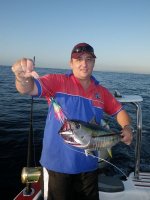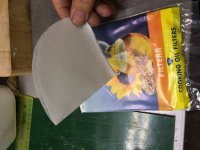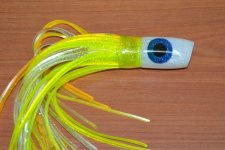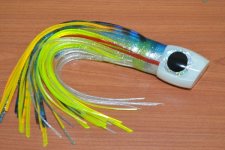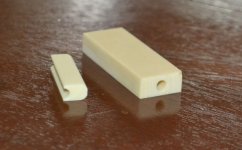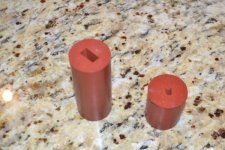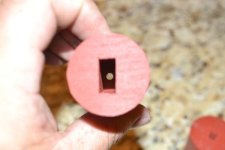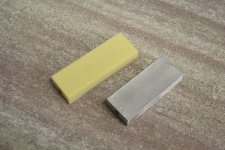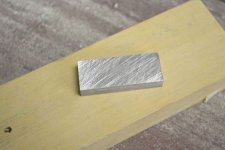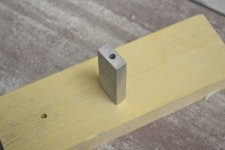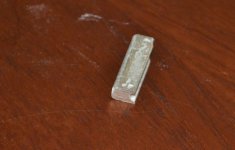You are using an out of date browser. It may not display this or other websites correctly.
You should upgrade or use an alternative browser.
You should upgrade or use an alternative browser.
Tutorial: How to make your own trolling lures
- Thread starter benniejordaan
- Start date
benniejordaan
Sealiner
Flippie wrote:
will be out there this weekend weather permitting. They haven't seen salt water yet.So where is the fotos of the fish caught on them
benniejordaan
Sealiner
benniejordaan
Sealiner
Cpt. Hook wrote:
Picked up a few small fish in that area, wrong timing... We were on our way back from the Billfish grounds 500-600mWe were out there yesterday also near that trawler, never saw you.
Loads of Oceanics and small Tuna around and the sea was so flat.
benniejordaan
Sealiner
kaboem wrote:
You are welcome. Thanks for taking the time to read it!WoW!!
Fantastic post Bennie!!
Thanks for sharing, awesome read!!
benniejordaan
Sealiner
Hi Everyone,
If you have any questions, please feel free to ask on the forum. Unfortunately, I do not respond to PM's. I would rather respond in the open forum for everyone's benefit...
Thanks
Bennie
If you have any questions, please feel free to ask on the forum. Unfortunately, I do not respond to PM's. I would rather respond in the open forum for everyone's benefit...
Thanks
Bennie
benniejordaan
Sealiner
benniejordaan
Sealiner
benniejordaan
Sealiner
benniejordaan
Sealiner
Shall we now move to the next step?
Discussing weighting lures and adding ballast.
Discussing weighting lures and adding ballast.
benniejordaan
Sealiner
OK, so now we have actually made some really nice fish catching lures. What you will find is the lures so far in this tutorial are perfect for what 90% of us are doing. We are fishing from small ski boats, most of which without outriggers. I wont go into why outriggers and and and but what we know is the lighter lures can be pulled a slower speeds 5-9 knots and they can be put a little further back while still having good action. They are also better suited to calmer conditions that most of us only fish in due to the size of our boats.
I am going to discuss 2 different weights now.
The first is what most of us are custom to. Simply making the lure heavier to suit rough conditions and also faster pulling speeds. It is also best suited to symmetrical lure shapes like conas, pushers and bullets. It basically entails making the insert from lead and it is simple to do. On a personal note though, I think weighting lures are over rated. You end up pulling lures too close to the transom where fish struggle to find them or running to fast. Some of the best lures in the world are completely un weighted. For example, lets consider Marlin Mags 10 top lures of all time. In that list we have the Mould craft super chugger and the Pakula Lumo sprocket, both unweighted. In fact the sprocket actually has buoyancy. We all know the Ilanders and Bobby Browns are deadly - also unweighted. This is because they are extremely versatile lures. Calm condition, close in and when the sea picks up, you can put them further out.
Below is a pic of both plugs we will be using to make the moulds for the weights. In the start of this tutorial we discussed making the inserts from urethane. We are basically going to use the same insert as our plug. The second smaller one in the pic is basically the same insert cut down to leave a half round for locating and gluing it to the plastic tube.
See from post #46
I am going to discuss 2 different weights now.
The first is what most of us are custom to. Simply making the lure heavier to suit rough conditions and also faster pulling speeds. It is also best suited to symmetrical lure shapes like conas, pushers and bullets. It basically entails making the insert from lead and it is simple to do. On a personal note though, I think weighting lures are over rated. You end up pulling lures too close to the transom where fish struggle to find them or running to fast. Some of the best lures in the world are completely un weighted. For example, lets consider Marlin Mags 10 top lures of all time. In that list we have the Mould craft super chugger and the Pakula Lumo sprocket, both unweighted. In fact the sprocket actually has buoyancy. We all know the Ilanders and Bobby Browns are deadly - also unweighted. This is because they are extremely versatile lures. Calm condition, close in and when the sea picks up, you can put them further out.
Below is a pic of both plugs we will be using to make the moulds for the weights. In the start of this tutorial we discussed making the inserts from urethane. We are basically going to use the same insert as our plug. The second smaller one in the pic is basically the same insert cut down to leave a half round for locating and gluing it to the plastic tube.
See from post #46







